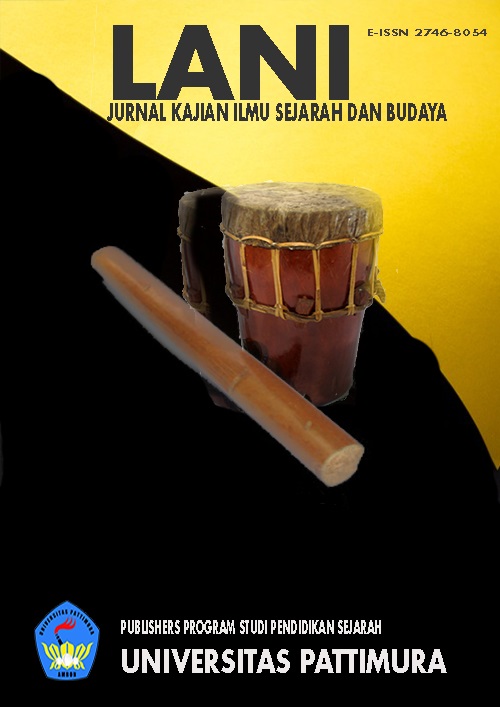Sejarah Baileo Baihata Kapalatu Dan Fungsinya Dalam Kehidupan Masyarakat Adat Negeri Ameth di Pulau Nusalaut Kabupaten Maluku Tengah
The History of Baileo Baihata Kapalatu and Its Function in the Life of the Indigenous Community of Negeri Ameth on Nusalaut Island, Central Maluku Regency.
Abstract
The Baileo located in Negeri Ameth is called Baihata Kapalatu, and the village's original name (teon) is Samasuru Amalatu. Etymologically, Samasuru Amalatu means a village led by a latu (king) established due to a command. Research shows that there are three entrances to this Baileo, each related to the roles of three villages: Ameth, Nalahia, and Akoon. In the past, these three villages were part of Ina Huhu, with Ameth serving as Ina Huhu's head and Titawaai as Ina Haha's head. According to some traditional elders, the southern entrance is for the village of Akoon, the western entrance is for Ameth, and the northern entrance is for Nalahia.
Before the construction of the Baileo in Negeri Ameth, all meetings concerning decision-making for issues related to Ameth were held in the old village in the mountains, where the community had yet to establish permanent residences. The people of Ameth believed they needed to move down to the coast and build a settlement. Using a tool called a lobe, which was thrown downwards, they decided where the lobe landed. A sacred stone was placed at this spot, and next to it, the Baileo of Negeri Ameth, named Baihata Kapalatu, was built. It is known that Baihata Kapalatu was originally the Baileo of Ina Huhu, belonging to Ameth as the king and Akoon and Nalahia as chiefs. Thus, all matters concerning these three villages were once handled within this Baileo. However, over time, the Baileo ceased to serve the towns of Akoon and Nalahia as they each built their own Baileo. Consequently, matters related to these two villages are no longer conducted in Baihata Kapalatu but are now handled within their respective Baileo. The Baileo in Negeri Ameth plays a vital role in conducting governmental ceremonies and traditional rituals within the village. The people of Ameth also believe that the Baileo is a sacred place that must be preserved and respected, as it is an integral part of the culture of the Maluku people, particularly the indigenous community of Negeri Ameth.
Downloads
References
Abdul Wahab Syakhrani, (2022). Budaya Dan Kebudayaan: Tinjauan Dari Berbagai Pakar, Wujud-Wujud Kebudayaan, 7 Unsur Kebudayaan Yang Bersifat Universal. Kalimantan Selatan, Jurnal iaisambas
Aslan, Setiawan, A., & Hifza. (2019). Peran Pendidikan dalam Merubah Karakter Masyarakat Dampak Akulturasi Budaya di Temajuk. FENOMENA, https:// doi.org/
Aslan, Sihaloho, N. T. P., Nugraha, I. H., Karyanto, B., & Zakaria, Z. (2020). Paradigma Baru Tradisi “Antar Ajung” Pada Masyarakat Paloh, Kabupaten Sambas. IBDA : Jurnal Kajian Islam Dan Budaya, 18 (1). https:// doi.org/
Cooley Frank, 1987. Mimbar dan tahta hubungan lembaga-lembaga keagamaan dan pemerintah di Maluku Tengah. Jakarta : Pustaka Sinar Harapan.
Hamid Dokolamo, (2020): Jurnal Lani: Kajian Ilmu Sejarah & Budaya “Matarumah Parentah Dalam Sistem Pemerintahan Adat di Maluku”. Program Studi Pendidikan Sejarah FKIP UNPATTI.
Hazairin, (1970). Demokrasi Pancasila. Jakarta: Tintamas
Husaini Usman dan Setiady Akbar. 2014. Metodologi Penelitian Sosial. Jakarta: PT Bumi Aksara.
Husein Alting, 2010. Dinamika Hukum Dalam Pengakuan Dari Perlindungan Hak Masyarakat Hukum Adat Atas Tanah. Yogyakarta: Laksbang PRESSindo.
Isna Zuriatina, (2020). Pengaruh Pembangunan Kebudayaan terhadap Pembangunan Manusia di Indonesia. Bandung: Sosiologi UINSGD Bandung
Koentjaraningrat, (2005). Kebudayaan Mentalitas dan Pembangunan. Jakarta : Gramedia Pustaka Utama
Koentjaraningrat, 2019. Pengantar Ilmu Antropologi, edisi revisi 2019. Penerbit Rineka Cipta. Jakarta
Maran, R. Raga, (2007). Manusia dan Kebudayaan Dalam Perspektif Ilmu Budaya Dasar. Jakarta : Rineka Cipta.
Margie C. Siahay. (2011). Citra dan Guna Pada Rumah Adat Maluku (Baileo), riarchitect blogspot.com
Marlyn Salhutery. (2016). Rumah Adat Baileo di Kecamatan Saparua Kabupaten Maluku Tengah, Balai Arkeologi Ambon
Moleong, J. Lexy, (2000). Metodologi Penelitian Kualitatif. Bandung : Tarsito
Moleong, J. Lexy, (2009) Metodologi Penelitian Kualitatif Edisi Refisi, Bandung : PT Remaja Rosdakarya
Moleong, J. Lexy, (2010) Metodologi Penelitian Kualitatif, Bandung : PT Remaja Rosdakarya
Muhammad Yasin Al-Arif, (2017), Tesis “Problematika Hukum Pengaturan Desa Dalam Konstitusi”. Universitas Islam Indonesia
Mulyadi, Yad, (1999). Pengantar Antropologi Budaya : Bandung : Alumni.
Pattiasina J, (2012). “Taong Vlaming” Pemerintahan De Vlaming, Perlawanan Rakyat dan
Pengaruhnya di Saparua tahun 1647-1656 (Tesis), Yogyakarta : FIB UGM. Pattipeilohy. M, (2014). Baileo Identitas Kekuasaan Adat Maluku Tengah.
Poerwadarminta, (1997). Kamus Lengkap Bahasa Indonesia. Surabaya : Kartika. Riani Tanjung, (2021): Jurnal Akuntansi “Editor In Chief” Politeknik Pos Indonesia
Setiadi M. Elly et al, (2006). Ilmu Sosial dan Budaya Dasar : Jakarta : Prenada Media Group Sugiyono, (2011). Metode Penelitian Kualitatif, Kualitatif R&D. Bandung : Alfabeta
William G. Patty dkk. 2021. Kearifan Lokal Adat ‘Tutup Baileo’ Di Desa Allang Kecamatan
Leihitu Kabupaten Maluku Tengah, Unstrat : Jurnal Holistik.
Copyright (c) 2024 Sontaria Balsala

This work is licensed under a Creative Commons Attribution-ShareAlike 4.0 International License.








